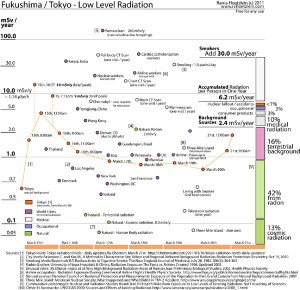* Note: I’m pleased to announce a new animated graphic of Fukushima radiation regional effects. Click here.
Click for detailed image.
Recent concerns with the Fukushima incident focus on levels of radiation reaching Tokyo.
Are the level of radiation high enough to warrant evacuation in Tokyo?
This scatter plot shows the levels of radiation recorded by Geiger-counter in Tokyo over the past 7 days. All units are in mSv/year. These values are compared with terrestrial background radiation in other cities in the world. Note, for example, that some cities such as Yiangjing, China emit 5.0 mSv/year naturally. Certain unique places such as Ramsar, Iran emit 260 mSv/year due to natural radioactive hotsprings. Denver, Colorado emits 2.0 mSv/year due to its high altitude. During the Fukushima incident, Tokyo measurements are between 0.3 mSv/y and 2.6 mSv/year.
Also shown are radiation levels due to cosmic background, radon, and medical uses. Radiation is cummulative, and the average annual radiation per person in the US is 6.4 mSv/year. 42% of this radiation comes from natural radon in the air. 10% comes from medical radiation. Typically, a single visit for a Chest X-ray, or CT Scan can provide the total budget of medical radiation for a whole year. CT Scans are considerably more radiant, giving off 18 mSv/dose for a Chest CT, and 40 mSv/dose for a Full body CT, whereas a normal X-ray is 0.06 mSv/dose. Smoking is a major contributor to annual radiation, adding 30 mSv/year when smoking 1.5 packs per day. This is significantly above the 6.4 mSv/year typically received for one per person. A television emits slightly above the natural background radiation.
The result of these findings is that direct radiation emitted from Fukushima presents no cause for concern. Its only been 7 days. A level of at least 10 mSv/year would need to be sustained — for the whole year — to make it a significant contribution to our annual radiation intake. Values in Tokyo currently average around what is typical in Denver, Colorado. Hence, elevated concern due to direct radiation is not warranted at this time.
However, another source of radiation in Tokyo is potential radioactive material, rather than direct radiation. Direct radiation coming from Fukushima falls off as the inverse square of distance, and can be measured by geiger-counter, which is shown in this plot. On the other hand, radioactive particles may be carried in the air and transported to Tokyo, and must be measured differently. Transported particles, suspended in air and carried by weather, could cause much higher radiation to occur directly in Tokyo. At present, I do not know of any direct particulate measurement data being taken in Tokyo.
Another possible source is the transport of larger particles by land. These could come from contaminated foods or from particles lodged in clothing from evacuees around Fukushima. So far, these levels are not high enough to warrant concern. Overall, one should be very wary of any media claims based on increased Geiger-counter measurements in Tokyo, while recordings of particulate radiation would be much more useful. The question we should be trying to answer is not, “How much radiation is there in Tokyo?”, the question should be: How much transported radioactive material is there in Tokyo?
It is important to note that other health factors are of much greater concern at these low radiation levels. For the average person, natural risks of cancer due to other factors such as genetics, risks associated with bad eating habits, or lack of exercise, are much more significant than those caused by these low levels of radiation. The only outstanding exception is smoking, as cigarettes contain lead and polonium which emit radioactive radiation while smoking. The cancer risks associated with smoking are 1 in 200, fours times higher than average. There are 1.7 million deaths caused by lung cancer in the world annual, and 91% of these are due to smoking.
Source material:
[1] Tokyo levels: Tokyo radiation levels – daily updates. Geiger counter readings by Chottom, March 21st. http://chottomatte.net/2011/03/16/tokyo-radiation-levels-daily-updates/
Alternatively, you can find up date radiation levels across Japan here.
[2] ] City levels: Passmore, C. and Kirr, M., A Method to Characterize Site, Urban and Regional Ambient Background Radiation. Radiation Protection Dosimetry. Oct 19, 2010
[3] Smoking levels: Ravenholt, R.T. Radioactivity in Cigarette Smoke. The New England Journal of Medicine, July 28, 1982. 306(6): 364-365
[4] Radon & other: University of Iowa Hospitals & Clinics. Radiation Exposure: The Facts vs. Fiction. Created 1996, Updated 2001.
[5] Unusual cities: M. Ghiassi-nejad, et al. Very High Background Radiation Areas of Ramsar, Iran: Preliminary Biological Studies, 2002. Health Physics Society.
[6] Airline occupation: Radiation Exposure During Commercial Airline Flights. Health Physics Society. http://www.hps.org/publicinformation/ate/faqs/commercialflights.html
[7] Natural sources: National Council on Radiation Protection and Measurements. Exposure of the Population in the US and Canada from Natural Background Radiation. 2007
[8] Three Mile Island: American Nuclear Society. What Happened and What Didn’t in TMI-2 Accident. http://www.ans.org/pi/resources/sptopics/tmi/
[9] Cumulative percentages: Nuclear and Radiation Studies Board. Bier VII: Health Risks from Exposure to Low Levels of Ionizing Radiation. Nat’l Academy of Sciences.
[10] Other source: H. Vanmarcke. UNSCEAR 2000: Sources and Effects of Ionizing Radiation. http://www.unscear.org/unscear/publications/2000_1.html


I love your charts and information.
However, there are different forms of radiation, e.g. Iodine-131, Cesium-137/134/135…., Plutonium, Uranium…
So, while your examples are really helpful, I suppose I’m still confused about how one can effectively make a comparison between something like ‘Background Radiation’ exposure versus the accumulations of specific elements like Iodine/Cesium.
E.g., what elements of radiation does an x-ray machine emit? (a % of all above-mentioned elements?)
Does smoking produce only Iodine? Or, are there other elements of radiation besides Iodine to consider in the example graphs you created?
From my very limited knowledge, I’ve come to understand that different elements of radiation are disbursed and affect the body in different ways. So, perhaps I’m really missing it, but, a more direct comparison between the examples of radiation exposure on your graph versus the ‘specific’ radioactive elements being released by Fukushima would be helpful in my opinion.
Hi all,
There has been some confusion online regarding how CT Scans can be compared to yearly background radiation. I’d like to clarify…
Dr. Jeffrey Toney, very early on, criticized the New York Times for comparing a single CT scan to on-going radiation at Fukushima. http://scienceblogs.com/deanscorner/2011/03/fukushima_radiation_levels_or.php
Initially, I was in agreement with his assesment of the NYT map.
I still agree that there is a general problem of how to show that radiation is _cummulative_, but, to be honest this is a problem of interpretation rather than visualization — i.e, how you read the map. When doing the map above, I came to conclusion that extending the Full Body CT Scan radiation of 10 mSv/dose out to on hour and saying this is 750 mSv/hour is itself misleading, because no one ever gets a CT scan for a full hour… ever.
How much radiation do you get from one Full Body CT scan in one session? 10 mSv, the total dose. How much do you get from that scan per hour? 10 mSv, still the total dose. How much do you get for a full year from one CT scan? 10 mSv, a single dose. It’s the same because it is a single, momentary dose. Although background radiation varies over time and is a continual exposure, these levels can be compared because they are both cumulative. If your total background exposure averages to 2 mSv/year, and you get a single full body CT scan in that year, then your total per year is 2 + 10 = 12 mSv/year.
Dr. Toney is correct in pointing out that the NYT map does not clarify that CT Scan is per dose. However, in the map above, I have tried to clarify this. Under each medical dose, I indicate this is the level you would get if you had one session per year, which is a reasonable way to present the data because this is typical for most people.
Putting a Full Body CT Scan into the unit mSv/year is reasonable, because this is the timescale on which we typically get such scans.
It seems that people tend to think of radiation as some kind of “level thats going up and down” in their body. But you have to think cumulatively, both for discrete and continuous exposures. As mentioned above, the way to interpret this map is to add up only those dots that apply to you for that year. I find it comforting to know that even simple things in nature are pretty complicated to grasp. More humorous is to watch the news media try to explain it.
I will also pitch in to buy you lunch if you ever come to Tokyo. Your charts are providing useful context and calming the anxiety for many people living here.
Thank you for making the time to do this. My Japanese friends are grateful that there are people all around the world who are using their talents to help them.
To Mary Byron,
Thanks very much for your comment. This is all that I think anyone doing visual work hopes for.
A friend of mine recently suggested that it might be worth translating into Japanese. Do you think this would be interesting or helpful? Do you know anyone who is fluent in Japanese and English who might like to try, or would have time to do so? As you are in Japan, and I know things are difficult there now, this question extends only if you think there would be real benefit to it.
Regards, Rama
Your charts about Fukushima are informational and beautiful. It is wonderful to have perspective and not just data points taken out of context. Please update when you have time. If you are ever in Tokyo, please do get in touch as it would be my pleasure to buy you lunch for such an excellent chart.
Could you expand on your explanation of the percent dose for typical people? The numbers on the right add to 86% only. Does the impact of smokers account for the remaining 14% experienced by the average person?
Super useful chart. Thanks!
Thanks for a great pictorial view of the measured radiation in Tokyo. I incorporated in a post for Tuesday.
http://blog.betterriskmanagement.com/2011/03/more-safety-questions-on-the-fukushima-daiichi-nuclear-plant
Please keep your Fukushima graphics updated!!
I just updated the map above with sources.
You can also find an article on the subject here:
http://scienceblogs.com/deanscorner/2011/03/are_you_getting_more_radiation.php
Hope to update with more data soon. I’ve decided to wait a little until events play themselves out, since it takes some effort to parse the data. That way future graphs it can be more of a retrospective.
Greetings, will this be updated after 2011 March 21?
Thanks for the excellent work.
interesting graph! really drives the point
i’d like to link people to this, but any chance of listing the sources for your info? Yhanks.